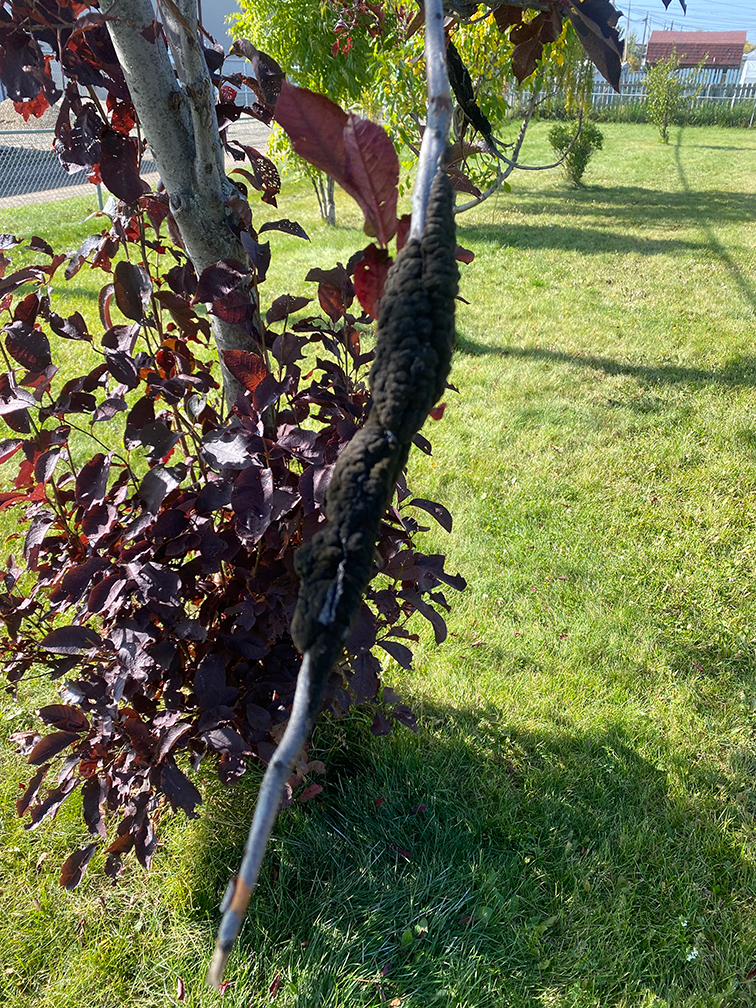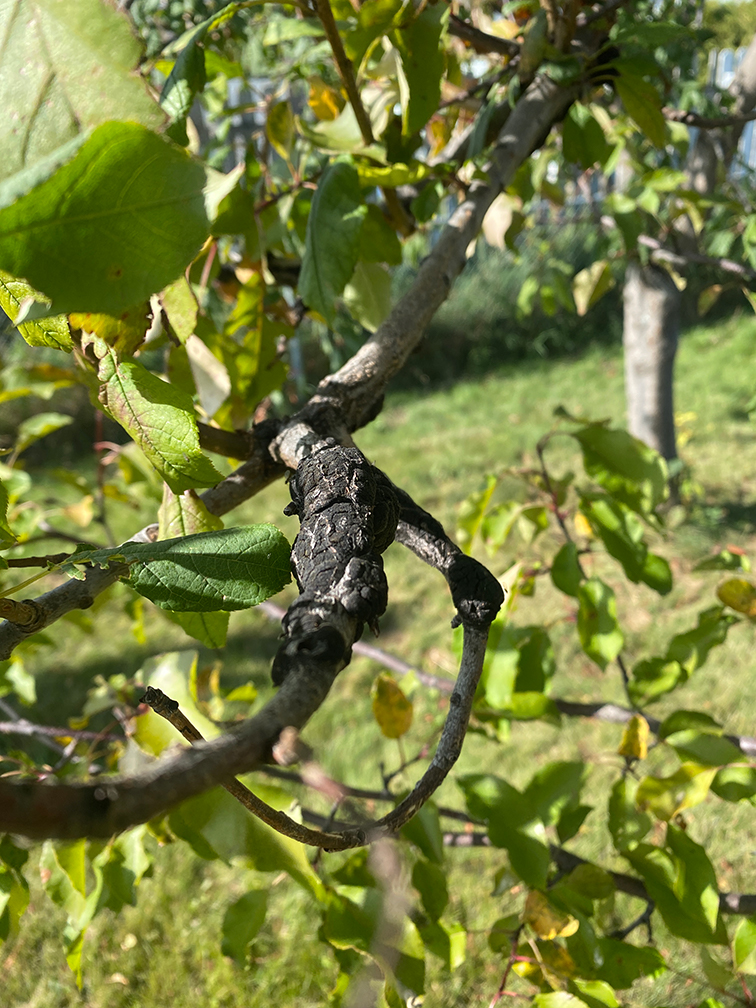Black Knot Fungus
What is Black Knot?
 Black Knot is a widespread fungal disease that attacks plum and cherry trees. It is easily identified with its hard, uneven, black galls that seem to enwrap twigs and branches. If left untreated it effectively strangles new growth, encircling the branches and dooming the tree to deterioration. The galls produced by the disease provide a gateway for additional disease and insect infestation which will be detrimental to the overall health of the tree.
Black Knot is a widespread fungal disease that attacks plum and cherry trees. It is easily identified with its hard, uneven, black galls that seem to enwrap twigs and branches. If left untreated it effectively strangles new growth, encircling the branches and dooming the tree to deterioration. The galls produced by the disease provide a gateway for additional disease and insect infestation which will be detrimental to the overall health of the tree.
The fungus, Apiosporina morbosa, singles out trees of the Prunus genus, which represents more than 400 species of flowering plants in the rose family.
Where is Black Knot Found?
Fort St. John, along with many other areas of British Columbia and Alberta is experiencing an infestation of Black Knot fungus. You likely have walked by a tree infected with Black Knot and wondered what on earth is that? Combating the disease requires cooperation from all citizens, businesses and municipalities to be vigilant and remove the black knot abnormalities.
Plant Species Affected
Black Knot affects Prunus genus plants of both fruit and ornamental varieties. Common trees affected are;
- Amur Cherry
- Mayday Tree
- Apricot
- Mongolian Cherry
- Black Cherry
- Nanking Cherry
- Chokecherry
- Pin Cherry
- Dropmore Cherry
- Cultivated Plum
- Flowering Almond
- Wild Plum
- Flowering Plum
- Prunus Hybrids
- Japanese Plum
- Sand Cherry
- Korean Cherry
- Sour Cherry
How to Recognize
 Black Knot is a slow developer, taking a season before it’s visually apparent and producing spores. During the first year after the tree has been infected, Black Knot is not obvious because the small, light-brown and/ or olive green swellings do not stand out, and the infected parts are often covered by dense foliage. It will develop at a succulent growth point as a result of spores landing and infection taking place. The trick to controlling the fungus is identifying the infection well-before the disease becomes firmly established.
Black Knot is a slow developer, taking a season before it’s visually apparent and producing spores. During the first year after the tree has been infected, Black Knot is not obvious because the small, light-brown and/ or olive green swellings do not stand out, and the infected parts are often covered by dense foliage. It will develop at a succulent growth point as a result of spores landing and infection taking place. The trick to controlling the fungus is identifying the infection well-before the disease becomes firmly established.
If left to grow the swelling will grow until it is mature after 2-3 years. The mature galls are easily identified as hard, black, 10 to 15 cm (4 to 6 inches) and may be somewhat ruptured. Mature galls will produce and release a vast amount of spores during the bloom period, resulting in a rapid increase in infections. The fungus continues to grow internally and externally, with the branch eventually becoming girdled and dying. It will effectively strangle new growth and the tree will be more susceptible to insects and other diseases using the galls to enter the tree.
April and June in particularly during wet, warm weather. A few common symptoms you may see are:
- A small, light brown swelling on/around former or current tree growth
- Enlarged swellings that appear as velvety, olive-green knots (indicating progressed growth from the previous year’s brown swellings)
The fungus releases spores heavily during blossom time, just before trees begin to leaf. After spore release, knots turn dark. By autumn they appear as black knots. Knots will continue to grow until they surround a given branch and kill it. If the infestation spreads, it may eventually kill the tree itself.
Black Knot Treatment
As with any tree disease, vigilance is key. Follow these tips to gain the upper hand in disease prevention or containment:
- Examine all trees annually and throughout the growing season for signs of black knot fungus. Look for cracks, discolouration, and swelling for the first signs of infection.
- Pruning should be done in the late fall, winter or early spring when the knots are both easy to see from lack of foliage and dormant.
- If you spot any galls, remove the infected branches at least six (6) inches, if possible up to twelve (12) inches away from the knot. Generously pruning out the infected parts ensures that you also remove the vegetative part of the fungus that does not visually appear as infected yet but will continue to grow if left on the tree. Failure to remove branches beyond the internal growth will result in re-growth of the fungus
- Ensure pruning blades are sharp, clean and disinfected with either bleach, isopropyl alcohol, rubbing alcohol or Pine-Sol.
- Sanitize your tools between cuts and afterwards to prevent reinfection.
- Also, remove diseased branches from any nearby infected trees, if possible.
- Destroy the infected branches before the tree buds. Even after the knots have been removed from the tree, they can produce infective spores for up to 4 months after removal. Safely discard the infected stems and branches by putting them in a securely tied trash bag for garbage collection/ landfill or burn them. Do not compost infected stems or branches.
- Prune annually until the disease is eradicated.
- A severely infected tree may be best to be cut down completely. Contact an Arborist or Tree Removal company to assist.
- Plant a different species that is not prone to the disease to help to eradicate black knot. Talk to your local nursery staff to see which species do best in your area.
Fungicides
Experts disagree about the effectiveness of fungicides on black knot disease; warning against relying on fungicides to cure this disease and prefer regular pruning of infected areas. Most experts agree that fungicides are ineffective unless you also follow good pruning and sanitization practices.
If monitoring and controlling Black Knot through pruning fails, or to protect young or highly susceptible trees that are likely to become infected, fungicide sprays may be applied. Fungicides can help to inhibit spore production but will not kill the fungus that is already present.
Fungicides should be applied in early spring before bud break and at regular intervals until the new shoots have matured. Make sure that the label specifies the use of the fungicide for your particular Prunus variety, and that it is registered for use on edible Prunus cultivars if that’s what you are using it for.
Preventing Black Knot
Prunus species are frequently infected with Black Knot. It is recommended to plant a different species that is not prone to the disease. Annual monitoring and pruning by citizens, business and municipalities will aid to eliminate Black Knot from the area.

